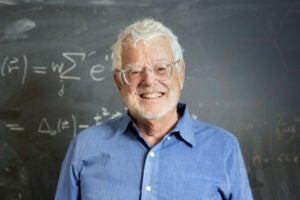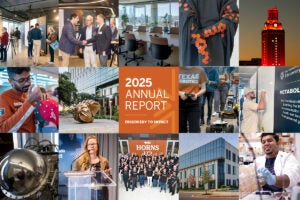We hear a lot of doom-and-gloom about the future.
The world will be too hot, too crowded. There will be too few resources and more competition for them.
We asked University of Texas at Austin researchers for the opposite — the ideas, technologies, policies or combinations that will make it possible for the world to be a better place in the future.
In this third installment of “The Big Question” series, Engineering Professor Rod Ruoff responds to the question “What in your field could make the world a better place?”
____________________________

The history of materials has evolved from the use of natural materials such as wood, rock, animal skin and others to man-made materials such as ceramics, metals, glasses, composites and semiconductors (i.e. electronic materials).
While life on earth has been based on carbon, new ways to arrange carbon atoms produce materials that are now at the cusp of a transition from basic science to scaled production that will lead systems and devices in the next several decades with heretofore unattainable performance. If this promise is fulfilled, it can so transform technology and society that in 25-50 years we will look back and refer to the Stone, Bronze, Iron and Steel Ages while living in the “Carbon Age.”
Energy, large-scale structures, autos and planes, information technology, electric motors, chemical and biological sensors and medical devices, will be particularly impacted. Energy harvesting and generation using carbon materials will revolutionize the way electricity is produced, stored and transmitted through improved solar and fuel cells, ultracapacitors and batteries, and implementation in high tension transmission lines. Extraordinary strength and light weight carbon structures made of new types of graphite (and graphene) and diamond will replace steel, aluminum and other current materials.
Carbon electronics promise exceptionally fast switching speeds, and ultrathin graphite has the potential to replace copper for communication, antennas, superinductors, and make possible electric motors one-third the weight of conventional motors.
New carbons in development show a path toward achieving electrical energy storage densities rivaling lead acid batteries but with much longer cycle life and improved efficiency. Strong, tough, low density continuous nanotube composites and components comprised of large area graphene and new forms of ultrathin graphite may allow design of automobiles and airplanes with exceptional improvement in fuel economy by significantly reducing weight.
Medicine can use new nano-carbons for micro-devices as carbon is perhaps the only material for non-metallic tiny electronic devices hermetically sealed for biomedical applications.
Graphene and ultrathin graphite will be integral in thermal management applications, from cooling computer chips to making buildings more energy efficient. Novel 3-D porous carbons that also have beautiful topologies (“negative curvature carbons”) will play a critical role as the likely ultimate electrode material for ultracapacitors.
It is particularly exciting to me that what one could call “the element of life” here on earth, carbon, when present in pure form and when 3-D (diamond, graphite, others), 2-D (graphene, the “honeycomb structure” of C-C bonds), or 1-D (carbon nanotubes), may be the element that, in such geometries, will drive a new industrial revolution.
Professor Rod Ruoff holds the Cockrell Family Regents Chair in the Department of Mechanical Engineering in the Cockrell School of Engineering.
Related content:



